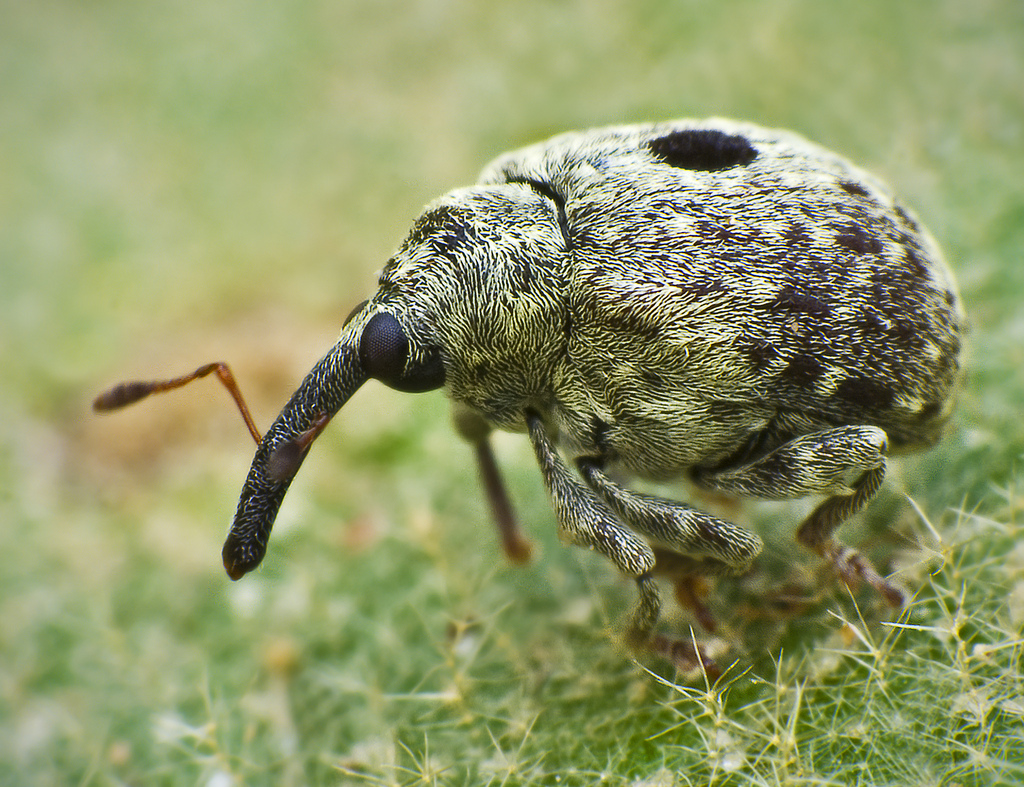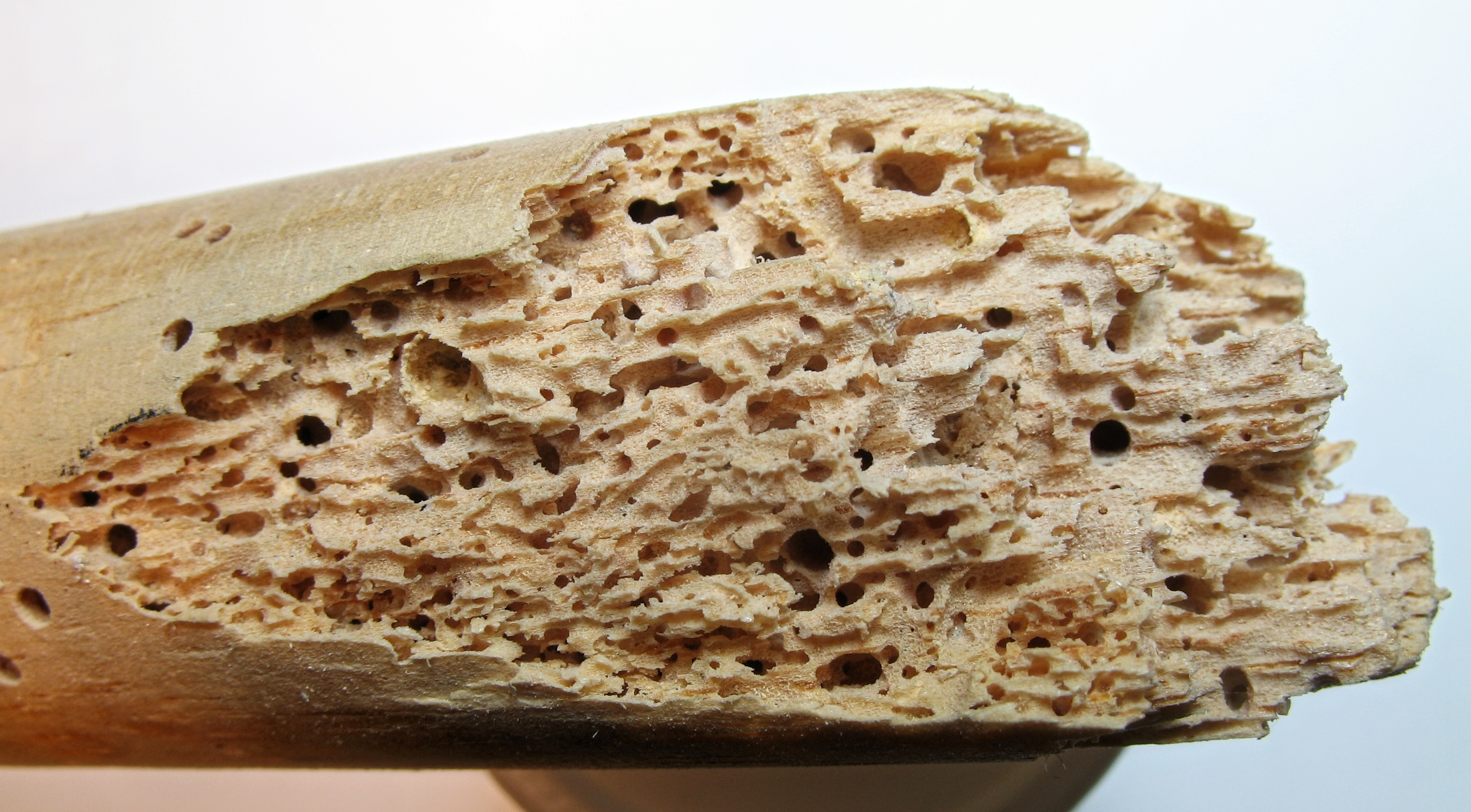|
Curculionidae
The Curculionidae are a family of weevils, commonly called snout beetles or true weevils. They are one of the largest animal families with 6,800 genera and 83,000 species described worldwide. They are the sister group to the family Brentidae. They include the bark beetles as the subfamily Scolytinae, which are modified in shape in accordance with their wood-boring lifestyle. They do not much resemble other weevils, so they were traditionally considered a distinct family, Scolytidae. The family also includes the ambrosia beetles, of which the present-day subfamily Platypodinae was formerly considered the distinct family Platypodidae. Description Adult Curculionidae can be recognised by the well-developed, downwards-curved snout (Rostrum (anatomy), rostrum) possessed by many species, though the rostrum is sometimes short (e.g. Entiminae). They have elbowed Antenna (biology), antennae that end in clubs, and the first antennal segment often fits into a groove in the side of the rost ... [...More Info...] [...Related Items...] OR: [Wikipedia] [Google] [Baidu] |
Weevil
Weevils are beetles belonging to the superfamily Curculionoidea, known for their elongated snouts. They are usually small – less than in length – and herbivorous. Approximately 97,000 species of weevils are known. They belong to several families, with most of them in the family Curculionidae (the true weevils). It also includes bark beetles, which while morphologically dissimilar to other weevils in lacking the distinctive snout, is a subfamily of Curculionidae. Some other beetles, although not closely related, bear the name "weevil", such as the leaf beetle subfamily Bruchinae, known as "bean weevils", or the biscuit weevil (''Stegobium paniceum''), which belongs to the family Ptinidae. Many weevils are considered pests because of their ability to damage and kill crops. The grain or wheat weevil (''Sitophilus granarius'') damages stored grain, as does the maize weevil (''Sitophilus zeamais''), among others. The boll weevil (''Anthonomus grandis'') attacks cotton crop ... [...More Info...] [...Related Items...] OR: [Wikipedia] [Google] [Baidu] |
Entiminae
The Entiminae are a large subfamily in the weevil family Curculionidae, containing most of the short-nosed weevils, including such genera as ''Entimus'', ''Otiorhynchus'', ''Phyllobius'', ''Sitona'', and ''Pachyrhynchus, Pachyrrhynchus''. In comparison with their stunning diversity, only a few of these weevils are notorious pest (organism), pests of major economic importance. Entimines are commonly encountered in the field, including urban environments, and abundant in entomological collections. Diversity There are over 12,000 described species in the Entiminae subfamily worldwide, distributed in over 1,370 genera, which total nearly 14,000 by more recent counts. Most tribes are represented in only one biogeographic region of the world. The current classification within the subfamily has been recognized as artificial rather than reflecting natural groups. General morphology Besides the shape of their broad and short rostrum, most entimines are easily recognized by the prese ... [...More Info...] [...Related Items...] OR: [Wikipedia] [Google] [Baidu] |
Coleoptera
Beetles are insects that form the Taxonomic rank, order Coleoptera (), in the superorder Holometabola. Their front pair of wings are hardened into wing-cases, elytra, distinguishing them from most other insects. The Coleoptera, with about 400,000 described species, is the largest of all orders, constituting almost 40% of described arthropods and 25% of all known animal species; new species are discovered frequently, with estimates suggesting that there are between 0.9 and 2.1 million total species. However, the number of beetle species is challenged by the number of species in Fly, dipterans (flies) and hymenopterans (wasps). Found in almost every habitat except the sea and the polar regions, they interact with their ecosystems in several ways: beetles often feed on plants and fungi, break down animal and plant debris, and eat other invertebrates. Some species are serious agricultural pests, such as the Colorado potato beetle, while others such as Coccinellidae (ladybirds or ... [...More Info...] [...Related Items...] OR: [Wikipedia] [Google] [Baidu] |
Maize Weevil
The maize weevil (''Sitophilus zeamais''), known in the United States as the greater rice weevil, is a species of beetle in the family Curculionidae. It can be found in numerous tropical areas around the world, and in the United States, and is a major pest of maize. This species attacks both standing crops and stored cereal products, including wheat, rice, sorghum,Control of Sitophilus zeamais Mots., 1958 and Sitophilus oryzae (L., 1763) weevils (Coleoptera, Curculionidae) in stored rice grain (Oryza sativa l.) with insecticide pirimiphos methyl (Actellic 500 CE) B. Alleoni1, W. Ferreira 9th International Working Conference on Stored Product Protection [...More Info...] [...Related Items...] OR: [Wikipedia] [Google] [Baidu] |
Bark Beetle
A bark beetle is the common name for the subfamily of beetles Scolytinae. Previously, this was considered a distinct family (Scolytidae), but is now understood to be a specialized clade of the "true weevil" family (Curculionidae). Although the term "bark beetle" refers to the fact that many species feed in the inner bark (phloem) layer of trees, the subfamily also has many species with other lifestyles, including some that bore into wood, feed in fruit and seeds, or tunnel into herbaceous plants. Well-known species are members of the type genus '' Scolytus'', namely the European elm bark beetle ''S. multistriatus'' and the large elm bark beetle ''S. scolytus'', which like the American elm bark beetle '' Hylurgopinus rufipes'', transmit Dutch elm disease fungi (''Ophiostoma''). The mountain pine beetle ''Dendroctonus ponderosae'', southern pine beetle '' Dendroctonus frontalis'', and their near relatives are major pests of conifer forests in North America. A similarly aggres ... [...More Info...] [...Related Items...] OR: [Wikipedia] [Google] [Baidu] |
Ambrosia Beetle
Ambrosia beetles are beetles of the weevil subfamilies Scolytinae and Platypodinae (Coleoptera, Curculionidae), which live in nutritional symbiosis with ambrosia fungi. The beetles excavate tunnels in dead or stressed trees into which they introduce fungal gardens, their sole source of nutrition. After landing on a suitable tree, an ambrosia beetle excavates a tunnel in which it releases its fungal symbiont. The fungus penetrates the plant's xylem tissue, extracts nutrients from it, and concentrates the nutrients on and near the surface of the beetle gallery. Ambrosia fungi are typically poor Wood-decay fungus, wood degraders, and instead utilize less demanding nutrients. Symbiotic fungi produce and detoxify ethanol, which is an attractant for ambrosia beetles and likely prevents growth of Antagonism (phytopathology), antagonistic pathogens and selects for other beneficial symbionts. The majority of ambrosia beetles colonize xylem (sapwood and/or heartwood) of recently dead trees, bu ... [...More Info...] [...Related Items...] OR: [Wikipedia] [Google] [Baidu] |
Baridinae
Baridinae is a subfamily of true weevils (Curculionidae). It was established by Carl Johan Schönherr in 1836. Some 4,300 species in 550 genera are placed here, most of which occur in the New World. A few are economically significant pest (organism), pests, while others are in turn used for biocontrol of invasive plant pests. This subfamily also contains a few endangered species. Description and ecology Baridinae are typically small to mid-sized short-legged weevils, with a characteristic round or ball-like shape. Usually colored black all over at least on the upperside, they are neither highly glossy or metallic, nor dull, but moderately shiny, like shoe polish, polished leather. Some have small dots or bands of lighter scales that can be rubbed off, in particular on the elytrae; yet again others are dusted with an irregular sprinkling of such scales. The elytrae are often decorated with neat lengthwise rows of small pits. The pronotum is not highly arched and may be outright ... [...More Info...] [...Related Items...] OR: [Wikipedia] [Google] [Baidu] |
Conotrachelus
''Conotrachelus'' is a genus of true weevils in the family Curculionidae. It is a very large genus with well over 1,000 species, several of which are pests of fruit crops.O'Brien, C. W., & Couturier, G. (1995)Two new agricultural pest species of ''Conotrachelus'' (Coleoptera: Curculionidae: Molytinae) in South America.''Annales de la Société Entomologique de France'' 31(3) 227-36. Found from Canada to Argentina. Species *'' Conotrachelus adspersus'' *'' Conotrachelus affinis'' *'' Conotrachelus albicinctus'' *'' Conotrachelus anaglypticus'' *'' Conotrachelus aratus'' *''Conotrachelus arizonicus'' *'' Conotrachelus asperatus'' *'' Conotrachelus belfragei'' *'' Conotrachelus biscaynensis'' *'' Conotrachelus buchanani'' *'' Conotrachelus cameronensis'' *'' Conotrachelus carinifer'' *'' Conotrachelus carolinensis'' *'' Conotrachelus cognatus'' *'' Conotrachelus compositus'' *'' Conotrachelus confinis'' *'' Conotrachelus conotracheloides'' *'' Conotrachelus corni'' *'' Conotrachelu ... [...More Info...] [...Related Items...] OR: [Wikipedia] [Google] [Baidu] |
Copturus
''Copturus'' is a genus of true weevils in the beetle family Curculionidae The Curculionidae are a family of weevils, commonly called snout beetles or true weevils. They are one of the largest animal families with 6,800 genera and 83,000 species described worldwide. They are the sister group to the family Brentidae. Th .... There are more than 190 described species in ''Copturus''. See also * List of Copturus species References Further reading * * * Weevils {{weevil-stub ... [...More Info...] [...Related Items...] OR: [Wikipedia] [Google] [Baidu] |
Woodboring Beetle
The term woodboring beetle encompasses many species and families of beetles whose larval or adult forms eat and destroy wood (i.e., are xylophagous). In the woodworking industry, larval stages of some are sometimes referred to as woodworms. The three most species-rich families of woodboring beetles are longhorn beetles, bark beetles and weevils, and metallic flat-headed borers. Woodboring is thought to be the ancestral ecology of beetles, and bores made by beetles in fossil wood extend back to the earliest fossil record of beetles in the Early Permian (Asselian), around 295-300 million years ago. Ecology Woodboring beetles usually attack dying or dead trees. In forest settings, they are important in the turnover of trees by culling weak trees, thus allowing new growth to occur. They are also important as primary decomposers of trees within forest systems, allowing for the recycling of nutrients locked away in the relatively decay-resilient woody material of trees. To reach matu ... [...More Info...] [...Related Items...] OR: [Wikipedia] [Google] [Baidu] |






